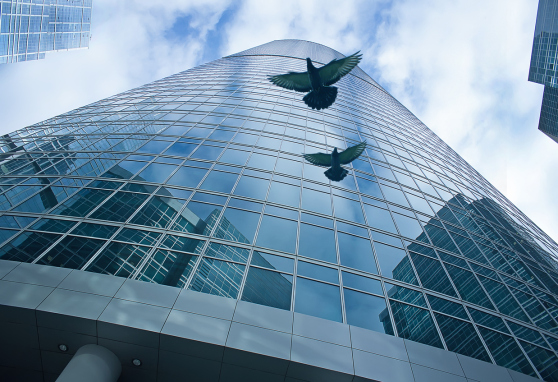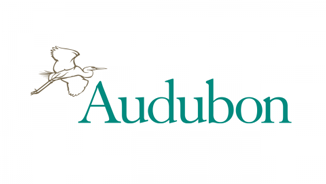
Posted June 30th 2020
Combatting Window Collisions with Bird-Friendly Solutions

Posted June 30th 2020
Combatting Window Collisions with Bird-Friendly Solutions
“[Architects and their clients] can use all the recycled material they want, they can save all the energy they want . . .But if their building is still killing birds, it’s not green to me.”
—Daniel Klem Jr. (from Audubon magazine)
Glass is everywhere. And while there’s no denying that glass buildings and structures are attractive to the human eye, our affinity for aesthetics doesn’t account for what glass might look like to a bird’s eye.
For the past 15 years Feather Friendly® bird deterrent markers, which uses some 3M™ technology in its proprietary product, have been used exclusively for the prevention of bird collisions.
Unlike traditional window films, Feather Friendly® is not a full coverage product but relies on small markers, which are placed on exterior windows. Its purpose is to reduce bird collisions by providing visual cues to birds to show that the glass is present. The markers are spaced in different patterns with the 2” x 2” spacing pattern being the most effective – this has also been written into the City of Toronto Bird-Friendly Development Guidelines and CSA Standards.
The introduction of bird-friendly solutions, and making them available to the mainstream market, allows municipalities, cities, and governing bodies to update and create legislations that cater to the birds that live in, and pass through, our towns and cities.
Fatal Attraction: When Birds and Windows Collide
According to The City of Toronto’s “Bird-Friendly Best Practices: Glass” guide, glass exteriors are an increasingly common feature on residential and commercial buildings. This increased use of glass has undoubtedly “increased the incidence of bird collisions.” The guide also estimates that in Toronto alone, most mid and high-rise buildings “contain more than 60 percent glass.” Fortunately, Toronto has reinforced the use of bird deterrent window markers to counteract the prevalence of glass in the city. Many cities across North America have followed Toronto’s lead by creating their own bird-friendly building legislations to recognize ongoing concern for migrating and nesting birds. The following characteristics of glass, provided by the American Bird Conservancy (ABC) Bird-Friendly Building Guide, are deadly to birds:
- Reflection: If you notice the sky or a park reflected in the windows of a building, you’re capable of understanding that it’s just a reflection. You might even admire it. But to a bird, those reflections appear to be an extension of their habitat that they will fly to, or try to go through, only to collide with the window.
- Transparency: Have you ever walked into a window or glass door without realizing it was there? When birds accidentally collide with glass, it’s often fatal: the glass is so clear that the birds don’t get a chance to “see” it before they hit it.
- “Black hole” effect: Birds have exceptional agility while in flight and they can weave in and out of foliage, dense branches and crevices with ease. However, reflective glass can sometimes provide the illusion of a dark passageway or opening for them, which causes them to move toward it, only to encounter a solid window.
Of course, collision rates depend on several factors like building height, design, location and the ecosystems that surround it. Even residential buildings can be deadly to birds, despite common assumptions that birds only collide with tall buildings.
Factors that Affect Bird Vision
We’re all familiar with the term “bird’s eye view,” but it only gives us some idea of what birds see and doesn’t actually give us any insight as to how they see.
So, if we can see the glass, why can’t the birds? As a structural material, glass can be refinished in many ways, which poses a deadly threat to birds. ABC’s Bird-Friendly Building Guide points out that since physical properties of glass vary, glass surfaces will change “appearance depending on environmental factors, including position relative to the sun, the difference between exterior and interior light levels, what may be reflected, and the angle at which it is viewed.” Despite our human ability to perceive glass, based on contextual cues, birds don’t have the ability to understand the concept of glass, which makes its ever-changing appearance especially dangerous.
Unfortunately, windows don’t just pose a threat to birds during daylight hours. ABC’s guide emphasizes the danger of artificial light, and its profound effect on migrating birds, as a troubling phenomenon that researchers are only starting to understand. Experts say that artificial light at night “plays a role in the number and distribution of collisions across the built environment.” Participating in a “lights out” initiative can combat the harmful effects of artificial light at night and enables you to actively prevent window collisions all day long.
How to Prevent Window Collisions
The ABC lists several solutions for reducing bird collisions and emphasizes the necessity of outfitting your residential windows, since “50 percent of bird collision mortality happens on home windows”.
The good news is you may already have bird-friendly windows without knowing it: mullions, the vertical piece between windowpanes and exterior screens help to prevent bird collisions by breaking up reflections on glass. If you don’t have screens on your exterior windows, there are a number of bird-smart techniques you can adopt to help you make your yard birds-safe. In addition to moving bird feeders away from windows, homeowners and businesses can prevent bird-collisions year-round by outfitting their windows with bird deterrent markers to minimize reflections, transparency, and the black hole effect.
Using Feather Friendly® window markers, or any kind of product that prevents window collisions, is a vital first step in helping to keep migratory and local birds safe. If you’re not sure where to start, check out FLAP Canada’s Building Assessment app to see where your home or office needs improvement.
Let’s Make Bird Safety Visible for Everyone
Bird collision solutions like Feather Friendly® do more than just raise awareness about species extinction or at-risk bird populations: they force us to make connections to our natural environment and to acknowledge the important contributions that birds make to our societies. Our willingness to embrace new standards in architecture, construction and bird deterrent technology can help us create customized legislations and standards that protect vital species from glass collisions. Make bird safety visible in your neighbourhood by purchasing our DIY tape or request information about a commercial installation today!
Partners
We are honoured to form partnerships with organizations who demonstrate
an ongoing commitment to bird conservation.



